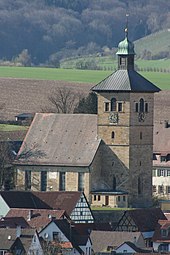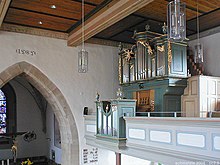Ulrichskirche (Eberstadt)
The Ulrich church is the parish church of the Protestant parish in Eberstadt in the district of Heilbronn in northern Baden-Württemberg . The high-Gothic choir tower church was built in place of a Romanesque predecessor structure from 1477 and expanded and rebuilt several times over the centuries. The church, which was called Lukaskirche until 1964 , is considered the most important art monument in Eberstadt.
description
The Ulrichskirche is located in the old town center of Eberstadt, right next to the town hall on a small hill that rises about 15 meters above the bottom of the Eberbach valley. The Kirchberg is supported by a high defensive wall. When a boiler room was excavated in 1951, the remains of a Neolithic hearth of the Rössen culture were found under the church . To the south of the church, in the churchyard within the defensive wall, there is the Eberstadt memorial for the war dead. The Protestant rectory in Eberstadt is opposite the church in the north.
The church is oriented in an east-west direction. In the east is the square choir tower , which was given its current shape in several construction stages. The high-Gothic basement with a pointed arch window on each of the three outer sides, which houses the choir inside, is believed to date from 1477 . In 1628 the tower was raised by the second floor with windows in the arched Renaissance style; the Eberstadt coat of arms, carved in stone next to the Württemberg coat of arms on the tower, is the oldest known representation of the tower. A final, octagonal structure made of wood was destroyed in a storm in 1816 and replaced in 1821 by another square stone structure with a simple roof and attached lantern ; at the same time a tower clock was installed. The sacristy , which was renovated in 1952, is attached to the south of the tower .
The nave adjoining to the west with the main portal in the west was enlarged from 1584 to 1586 and renovated in a late manner . The interior was fundamentally redesigned from 1961 to 1963; two galleries in the south and north were demolished, the larger west gallery remained. The Walcker organ from 1789 (rebuilt and expanded in 1898 and 1936, replaced by a Kern organ in 1986 ) is located on a new, smaller southern gallery . The baroque pulpit from 1728, previously installed on the right side of the church interior and only accessible from the sacristy, has been moved to the left.
A triumphal arch leads to the choir in the basement of the tower, the year 1585 above commemorates the renovation of the nave. The cross vault of the choir is painted with the signs of the four evangelists , the paintings are believed to date from the late 16th century. The current choir windows were added during the renovation in the 1960s.
Bells
For a long time, the ringing of the Eberstadt church consisted of two or three bells in an oak bell cage . One of these bells, the medium-sized or 11 o'clock bell , came from 1457 and thus probably from the Romanesque predecessor of today's church, which was demolished in 1477. When the headquarters of the French troops under Marshal Turenne stopped in nearby Willsbach on August 21, 1645 during the Thirty Years War , the citizens of Eberstadt are said to have quickly fetched this bell from the tower and buried it, which is why it was preserved, while another, larger bell was either delivered or had to be sold to pay contributions (war payments ).
In 1652 this large bell was replaced by the new 12 o'clock bell , weighing 850 kg and cast by Wolfgang Roth in Nuremberg . In 1831 a small bell, cast at the Bachert bell foundry in Kochendorf , added to the ringing, which from 1910 hung in an iron bell cage. As early as 1917, during the First World War , the bell from 1831 had to be returned, while the other bells were not confiscated because of their historical value. In 1921 the 11 o'clock bell failed after 464 years. It and the confiscated bell were replaced by two new Bachert bells in the same year. In the Second World War two bells were confiscated again, only the smallest was spared. The bell from 1652 was returned in January 1948. In November 1959, three new bells cast by Bachert in Heilbronn were added, so that the ringing has since been five bells.
| Surname | Founder, year of casting |
Percussion tone |
Weight (kg) |
inscription | symbol |
|---|---|---|---|---|---|
| Prayer bell | Alfred Bachert, Heilbronn 1959 | it ' +6/16 | 1 302 | Pray to the Lord in holy ornament (Psalm 96: 9) | Divine Trinity |
| Arbitration bell | Wolfgang Roth, Nuremberg 1652 | f ' +8/16 | 850 | ||
| Cross bell | Alfred Bachert, Heilbronn 1959 | as' +8/16 | 500 | Let's look up to Jesus (Hebr. 12: 2) |
Crucifixion of Christ |
| Drawing bell | Alfred Bachert, Heilbronn 1959 | b ' +8/16 | 334 | Blessed are those who hear the word of God and keep it (Luke 11:28) | Ulrichskirche with Α and Ω as well as symbol of the Holy Spirit |
| Baptismal bell | Bachert brothers, Kochendorf 1921 | c '' +6/16 | 299 |
history
According to excavation finds, there was a Romanesque chapel, probably built between 1000 and 1150, at the same place as today's church. This church was first mentioned in a document in 1247: On December 11th, Pope Innocent IV confirmed his possessions in a lead bull to the Oberstenfeld monastery , including the patronage right of the Eberstadt church, which was then consecrated to the evangelist Luke . Another document of Innocent IV of December 23, 1249 shows that the parish Eberstadt belonged to the diocese of Würzburg .
After the Romanesque church was demolished, a larger building was erected in the 15th century; According to an inscription on the north side of the tower, construction began probably in 1477. The basement of the church tower with the three Gothic pointed arched windows comes from this time. From 1584 to 1586 the nave was enlarged and renewed, and in 1596 a new cemetery was laid out outside the village in the northwest; the churchyard previously used for this purpose had become too narrow. In 1628 the tower was raised by the second floor with windows in the arched Renaissance style. In 1803, after more than 550 years, the patronage of the Oberstenfeld Monastery over the Eberstädter Church ended, and the Württemberg Higher Church Authority took its place.
On the evening of August 5, 1816, a devastating cyclone accompanied by hail struck Eberstadt and also destroyed the top, octagonal wooden floor of the church tower. Due to a lack of money, the tower was only rebuilt in its current form in 1821 with a square end and a lantern attached . In the same year a tower clock was installed below the bell chamber, which had to give way to a new clock in 1922. In 1892 the church was completely renovated under Heinrich Dolmetsch , and in 1928 the architect Hans Seytter renewed the interior. After the church was damaged during World War II by bombardment by fighter bombers and an aerial bomb explosion in the churchyard south of the church, it was initially secured in the immediate post-war period by installing new windows and repairing the damaged roofs of the tower and ship. The high wall supporting the churchyard, which threatened to collapse, was demolished in 1949 and rebuilt; the churchyard, which until then served as a school garden, was turned into a lawn. With the demolition of the dilapidated sacristy and its reduced reconstruction, a renewed renovation began in 1952/53 under Hannes Mayer , which was continued by the architect Heinz Klatte from 1961 and lasted until 1963. First, the church tower was completely renovated and completely re-covered with copper (instead of slate previously), then the nave was partially re-covered and the interior was completely redesigned. The renewed church was consecrated on Sunday, March 1st, 1964.
During research into the history of the church, the Eberstadt pastor Gerhard Eiselen (in office from 1953 to 1966) discovered files and documents from which he believed he could conclude that it was not the evangelist Luke , but actually Saint Ulrich who was the patron saint of the Eberstadt church. In 1964 the Lukaskirche was renamed Ulrichskirche. It is unclear whether the naming as St. Luke's Church in 1247 was a mistake or a later misinterpretation or whether the patron saint changed over the course of time, for example during a church renovation. It is also possible that the files that mention Ulrich refer to an Ulrich altar.
literature
- Heinz Dörnen: Eberstadt. A chronicle of the community . Eberstadt municipality, Eberstadt 1985. pp. 39–63
- Julius Fekete: Art and cultural monuments in the city and district of Heilbronn . 2nd Edition. Theiss, Stuttgart 2002, ISBN 3-8062-1662-2 . P. 142
Remarks
- ↑ Printed u. a. in: Wirtemberg document book . Volume IV, No. 1102. Stuttgart 1883, p. 163 f. ( Digitized version , online edition )
- ↑ Printed u. a. in: Wirtemberg document book . Volume IV, No. 1135. Stuttgart 1883, pp. 200 f. ( Digitized version , online edition )
Individual evidence
- ↑ a b Fekete, s. literature
- ↑ a b Hartmut Wolf and Joachim Frankhänel: The Ulrichskirche in Eberstadt . In: Evangelical churches in the deanery Weinsberg . Protestant Dean's Office Weinsberg, Weinsberg 2003. pp. 10–11
- ↑ Dörnen (see literature), p. 53
Web links
- Article about the bells of the Ulrichskirche at kirche-eberstadt.de (PDF, 411 KB)
Coordinates: 49 ° 10 ′ 43.4 " N , 9 ° 19 ′ 16.25" E





